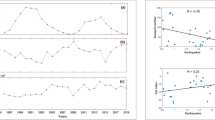Abstract
Earthquakes occur as the natural outcome of the processes that govern a dynamic planet, one that supports plate motions. The internal structure of the Earth that can sustain the convective -ow of the mantle and the presence of a strong, fractured outer shell, the lithosphere that can glide over the underlying asthenosphere are important components of the plate tectonic framework, and therefore, the global distribution of earthquakes. With an introduction to the ideas of plate tectonics and earthquake terminology, this article introduces the significance of the India-Eurasia plate boundary and its seismic productivity. The most active continent-continent collision boundary on the Earth defined by the Himalaya and the Andaman-Sumatra subduction zone are part of this plate boundary. Parts of the Indian continental interior regions are also noted for some destructive earthquakes. This article provides a brief overview of the background processes, terminology, and some highlights on Indian earthquakes studies, and points to academic opportunities in the area of earthquake studies.
Similar content being viewed by others
Suggested Reading
P Keary, Keith A Klepeis and Federick A Vine, Global Tectonics (3rd ed),Wiley Blackwell, p.463, 2009.
H Kanamori, Energy Release in Great Earthquakes, Journal of Geophysical Research, Vol.82, No.20, pp.2981–2987, Bibcode:1977JGR....82.2981K, doi:10.1029/jb082i020p02981, 1983.
H Kanamori, Magnitude Scale and Quantification of Earthquakes, Tectonophysics, Vol.93, pp.185–199, 1983.
Bruce A Bolt, Earthquakes: A Premier, San Francisco, CA: WH Freeman and Company, 1978.
R M Parameswaran, K Rajendran, Structural Context of the 2015 Pair of Nepal Earthquakes (Mw 7.8 and Mw 7.3): An Analysis Based on Slip Distribution, Aftershock Growth, and Static Stress Changes, International Journal of Earth Sciences, pp.1–14, 2016.
C P Rajendran, K Rajendran, J Sanwal and M Sandiford, Archeological and Historical Database on the Medieval Earthquakes of the Central Himalaya: Ambiguities and Inferences, Seism. Res. Lett., Vol.87, pp.1098–1108, 2013.
K Rajendran, R Parameswaran and C P Rajendran, Seismotectonic Perspectives on the Himalayan Arc and Contiguous Areas: Inferences From past and Recent Earthquakes, Earth-Science Reviews, Vol.173, pp.1–30, 2017.
C P Rajendran, B John and K Rajendran, Medieval Pulse of Great Earthquakes in the Central Himalaya: Viewing Past Activities on the Frontal Thrust, J. Geophys. Res. Solid Earth., pp.1623-1641, http://dx.doi.org/10.1002/2014JB011015.
C P Rajendran, K Rajendran, M Thakkar and B Goyal, Assessing the Previous Activity at the Source Zone of the 2001 Bhuj Earthquake Based on the Near Source and Distant Paleoseismological Indicators, J.Geophys. Res. Solid Earth., Vol.113, p.B05311, doi:10.1029/2006JB004845, 2008.
C P Rajendran, K Rajendran, V Vanessa Andrade and S Srinivasalu, Ages and Relative Sizes of Pre-2004 Tsunamis in the Bay of Bengal Inferred from Geologic Evidence in the Andaman and Nicobar Islands, J. Geophys. Res. Solid Earth., Vol.118, pp.1345–1362, doi:10.1002/jgrb.50122, 2013.
K Rajendran and C P Rajendran, Seismogenesis in the Stable Continental Regions and Implications for Hazard Assessment: Two Recent Examples from India, Current Science, Vol.85, No.7.
http://www.iris.edu/hq/inclass/video/tectonic_lithospheric_plates_commonly_confused_with_crust, 2003.
www.usgs.gov
www.iris.edu
https://earthquake.usgs.gov/learn/glossary/?term=Richter%20scale
Author information
Authors and Affiliations
Corresponding author
Additional information
Kusala Rajendran is a Professor of Earth Sciences at the Indian Institute of Science, Bangalore. Her research interests are mostly in understanding the source mechanisms of earthquakes along the plate boundaries.
Rights and permissions
About this article
Cite this article
Rajendran, K. Earthquakes as Expressions of Tectonic Activity. Reson 23, 337–353 (2018). https://doi.org/10.1007/s12045-018-0622-2
Published:
Issue Date:
DOI: https://doi.org/10.1007/s12045-018-0622-2



